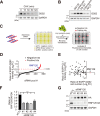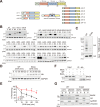A molecular triage process mediated by RING finger protein 126 and BCL2-associated athanogene 6 regulates degradation of G0/G1 switch gene 2
- PMID: 31371451
- PMCID: PMC6779449
- DOI: 10.1074/jbc.RA119.008544
A molecular triage process mediated by RING finger protein 126 and BCL2-associated athanogene 6 regulates degradation of G0/G1 switch gene 2
Abstract
Oxidative phosphorylation generates most of the ATP in respiring cells. ATP is an essential energy source, especially in cardiomyocytes because of their continuous contraction and relaxation. Previously, we reported that G0/G1 switch gene 2 (G0S2) positively regulates mitochondrial ATP production by interacting with FOF1-ATP synthase. G0S2 overexpression mitigates ATP decline in cardiomyocytes and strongly increases their hypoxic tolerance during ischemia. Here, we show that G0S2 protein undergoes proteasomal degradation via a cytosolic molecular triage system and that inhibiting this process increases mitochondrial ATP production in hypoxia. First, we performed screening with a library of siRNAs targeting ubiquitin-related genes and identified RING finger protein 126 (RNF126) as an E3 ligase involved in G0S2 degradation. RNF126-deficient cells exhibited prolonged G0S2 protein turnover and reduced G0S2 ubiquitination. BCL2-associated athanogene 6 (BAG6), involved in the molecular triage of nascent membrane proteins, enhanced RNF126-mediated G0S2 ubiquitination both in vitro and in vivo Next, we found that Glu-44 in the hydrophobic region of G0S2 acts as a degron necessary for G0S2 polyubiquitination and proteasomal degradation. Because this degron was required for an interaction of G0S2 with BAG6, an alanine-replaced G0S2 mutant (E44A) escaped degradation. In primary cultured cardiomyocytes, both overexpression of the G0S2 E44A mutant and RNF126 knockdown effectively attenuated ATP decline under hypoxic conditions. We conclude that the RNF126/BAG6 complex contributes to G0S2 degradation and that interventions to prevent G0S2 degradation may offer a therapeutic strategy for managing ischemic diseases.
Keywords: ATP; BCL2-associated athanogene 6; RING finger protein 126 (RNF126); hypoxia; ischemic heart disease; mitochondria; protein degradation; small interfering RNA (siRNA); ubiquitin ligase.
© 2019 Kamikubo et al.
Conflict of interest statement
The authors declare that they have no conflicts of interest with the contents of this article
Figures







Similar articles
-
In vivo real-time ATP imaging in zebrafish hearts reveals G0s2 induces ischemic tolerance.FASEB J. 2020 Feb;34(2):2041-2054. doi: 10.1096/fj.201901686R. Epub 2020 Jan 8. FASEB J. 2020. PMID: 31916304
-
Evaluation of intramitochondrial ATP levels identifies G0/G1 switch gene 2 as a positive regulator of oxidative phosphorylation.Proc Natl Acad Sci U S A. 2014 Jan 7;111(1):273-8. doi: 10.1073/pnas.1318547111. Epub 2013 Dec 16. Proc Natl Acad Sci U S A. 2014. PMID: 24344269 Free PMC article.
-
Structural and functional insights into the E3 ligase, RNF126.Sci Rep. 2016 May 19;6:26433. doi: 10.1038/srep26433. Sci Rep. 2016. PMID: 27193484 Free PMC article.
-
CHIP: a co-chaperone for degradation by the proteasome.Subcell Biochem. 2015;78:219-42. doi: 10.1007/978-3-319-11731-7_11. Subcell Biochem. 2015. PMID: 25487024 Review.
-
p53 regulation: teamwork between RING domains of Mdm2 and MdmX.Cell Cycle. 2011 Dec 15;10(24):4225-9. doi: 10.4161/cc.10.24.18662. Epub 2011 Dec 15. Cell Cycle. 2011. PMID: 22134240 Review.
Cited by
-
BAG6 supports stress fiber formation by preventing the ubiquitin-mediated degradation of RhoA.Mol Biol Cell. 2023 Apr 1;34(4):ar34. doi: 10.1091/mbc.E22-08-0355. Epub 2023 Mar 8. Mol Biol Cell. 2023. PMID: 36884293 Free PMC article.
-
E3 ubiquitin ligase RNF126 affects bladder cancer progression through regulation of PTEN stability.Cell Death Dis. 2021 Mar 4;12(3):239. doi: 10.1038/s41419-021-03521-1. Cell Death Dis. 2021. PMID: 33664240 Free PMC article.
-
BAG6 prevents the aggregation of neurodegeneration-associated fragments of TDP43.iScience. 2022 Apr 20;25(5):104273. doi: 10.1016/j.isci.2022.104273. eCollection 2022 May 20. iScience. 2022. PMID: 35542047 Free PMC article.
-
Protein quality control machinery supports primary ciliogenesis by eliminating GDP-bound Rab8-family GTPases.iScience. 2023 Apr 10;26(5):106652. doi: 10.1016/j.isci.2023.106652. eCollection 2023 May 19. iScience. 2023. PMID: 37182096 Free PMC article.
-
Recent advances on the role of G0S2.Discov Oncol. 2025 Jul 18;16(1):1362. doi: 10.1007/s12672-025-03198-4. Discov Oncol. 2025. PMID: 40679675 Free PMC article. Review.
References
-
- Semenza G. L., Jiang B. H., Leung S. W., Passantino R., Concordet J. P., Maire P., and Giallongo A. (1996) Hypoxia response elements in the aldolase A, enolase 1, and lactate dehydrogenase A gene promoters contain essential binding sites for hypoxia-inducible factor 1. J. Biol. Chem. 271, 32529–32537 10.1074/jbc.271.51.32529 - DOI - PubMed
-
- Kioka H., Kato H., Fujikawa M., Tsukamoto O., Suzuki T., Imamura H., Nakano A., Higo S., Yamazaki S., Matsuzaki T., Takafuji K., Asanuma H., Asakura M., Minamino T., Shintani Y., et al. (2014) Evaluation of intramitochondrial ATP levels identifies G0/G1 switch gene 2 as a positive regulator of oxidative phosphorylation. Proc. Natl. Acad. Sci. U.S.A. 111, 273–278 10.1073/pnas.1318547111 - DOI - PMC - PubMed
Publication types
MeSH terms
Substances
LinkOut - more resources
Full Text Sources
Research Materials

